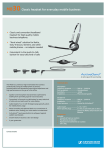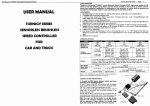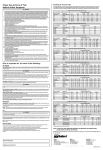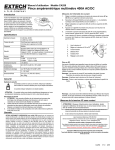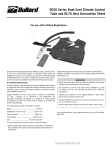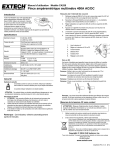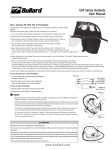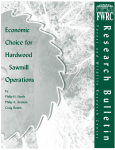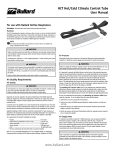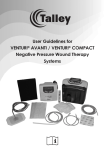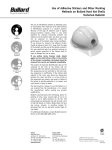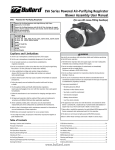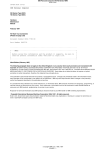Download Thermal Imager User Manual
Transcript
MB30 Series Airline Respirator User Manual TM TYPE C AND CE Continuous-Flow Class MSHA/NIOSH Approval No. TC-19C-314 General Information Bullard’s MB30 airline respirators, when properly used, provide a continuous flow of air from a remote air source to the respirator wearer. MB30 respirators offer protection from airborne contaminants that are not immediately dangerous to life or health (IDLH), as defined at 29 CFR 1910.134(b), or that do not exceed concentrations allowed by applicable OSHA, EPA, NIOSH or ACGIH regulations and recommendations. MB30 airline respirators are approved by MSHA/NIOSH (TC-19C314 Type C and CE). Bullard has determined that these respirators may be used to provide respiratory protection in general purpose applications such as painting, glass etching, monument blasting, automotive and aircraft body repair, architectural paint removal, furniture and ornamental paint removal. The materials from which the MB30 airline respirator is constructed are not durable enough to withstand repeated exposures to abrasive blasting. Repeated use for abrasive blasting and/or use in industrial or heavy blasting operations may tear holes in the material which could allow the intrusion of contaminants and/or toxic substances. If this MB30 respirator is used for abrasive blasting, it should only be used for occasional, light duty, outside blasting or for abrasive operations where the blaster is physically separated from the blasting nozzle. Bullard models 88VX and Lancer abrasive blasting respirators with hard-shell helmets would be better suited for industrial or regular abrasive blasting applications. WARNING Read all instructions and warnings before using these respirators. Save this manual for future reference. If the MB30 airline respirator is used in abrasive blasting operations, it is imperative that the employer and user be diligent in complying with all OSHA regulations including those pertaining to inspections of the respirator for worn or deteriorated parts and the immediate replacement of same. Failure to follow this warning or any other user instructions may result in death or delayed lung disease. MB30 respirators are compatible with breathing air sources such as breathing air compressors or Bullard Free-Air® Pumps. Bullard offers the appropriate approved breathing tube assembly and air supply hose to connect the MB30 respirator to these breathing air sources. MB30 respirators are approved by NIOSH for use with optional Bullard climate control devices: AC1000 Series, HC2400 Series, Frigitron® 2000 Series and Dual-Cool®. Table of Contents General Information ................................................................1 MB30 Respirator Use Approval Label ..........................................................................2 Donning ..........................................................................................9 Doffing............................................................................................9 Component Concept ................................................................3 Warnings ......................................................................................4 Operations Protection ......................................................................................5 Breathing Air Requirements ..........................................................5 Breathing Air Pressure ..................................................................5 Breathing Air Supply Hoses and Hose Fittings ............................5 Breathing Air Pressure Table ........................................................6 MB30 Respirator Assembly Inspection, Cleaning, and Storage Hood and Headband ....................................................................10 Hard Hat ......................................................................................10 Breathing Tube Assembly ............................................................10 Air Supply Hoses..........................................................................10 Storage ........................................................................................10 Parts and Accessories for MB30 Airline Respirator...................................................... 11 Return Authorization ............................................................12 Adjusting and Installing Headband in Respirator Hood ..............7 Adjusting and Installing Hard Hat in Respirator Hood ................7 Installing Breathing Tube Assembly into Air Delivery System......8 Using Climate Control Devices ......................................................8 www.bullard.com TM MB30 Approval Label APPROVAL LABEL MB30 Respirator System PERMISSIBLE AIRLINE RESPIRATOR TYPE C and CE CONTINUOUS-FLOW CLASS Breathing Tube Assembly (Part No.) Air Supply Hose (Part No.) Air Supply Hose Length (Feet) Maximum Number of Hose Sections Required Pressure Range (psig air) V30, V30B, V30S, V31, V32, V33, V34, V37 V10 25 50 100 150 200 250-300 1 2 3 4 5 5 14-15 15-18 19-24 23-29 25-34 31-39 V5 25 50 1 2 12-18 19-23 V40, V40B, V40S, V41, V42, V43, V44, V47 V10 25 50 100 150 200 250-300 1 2 3 4 5 5 22-25 24-27 27-32 30-37 33-40 38-45 V5 25 50 1 2 22-26 25-30 AC100030, AC100030B, AC100030S, AC100031, AC100032, AC100033, AC100034, AC100037, V10 25-50 75-150 175-300 2 3 5 55-65 60-70 65-75 V5 25 50 1 1 55-65 56-69 DC5040, DC5041, DC5042, DC5047, V10 50 100 150 200 250 300 2 3 3 3 3 5 48-52 59-63 68-72 80-84 85-92 90-98 V5 25 50 1 2 53-57 67-71 HC240030, HC240030B, HC240030S, HC240031, HC240032, HC240033, HC240034, HC240037 V10 25 50 100 150 200 250 300 1 2 3 4 4 5 5 59-61 63-65 68-70 73-75 77-79 80-82 84-86 V5 25 50 1 1 65-66 68-69 V35, V35B, V35S V20 50 100 200 300 1 2 2 3 4-6 6-8 10-15 13-18 FRIGITRON® 2000, FRIGITRON 2000B, FRIGITRON 2000S V20 50 100 200 300 1 2 2 3 16-221 18-25 22-30 25-34 Mine Safety and Health Administration National Institute for Occupational Safety and Health APPROVAL NO. TC-19C-314 ISSUED TO: Bullard E.D. Bullard Company Cynthiana, Cynthiana, Kentucky, Kentucky, USA LIMITATIONS: Approved for respiratory protection in any atmosphere not immediately dangerous to life or health and from which the wearer can escape without the aid of the respirator. This approval applies only when the respirator is supplied with respirable air through approved hose(s), in allowable length(s), through belt-mounted aircontrol systems, including accessories, at pressure ranges shown in the table. The chin strap will aid in securing the suspension to the head and must be worn at all times. CAUTION: Do not wear this respirator in any atmosphere immediately dangerous to life or health. Follow manufacturer’s instructions for providing a supply of respirable air. In making renewals or repairs, parts used must be identical to those furnished by the manufacturer under the pertinent approval. This respirator shall be selected, fitted, used and maintained in accordance with Mine Safety and Health Administration, Occupational Safety and Health Administration and other applicable regulations. Bullard MB30 Series airline respirator consists of the following components: respirator hood and cape, headband or head protection, breathing tube assembly and air supply hose. All components must be present and properly assembled to constitute a complete MSHA/NIOSH approved respirator. See pages 3-4 of the instruction manual for the approved assembly parts. MB30 Approval Label MSHA/NIOSHApproval ApprovalNo. No. TC-19C-314. Issued to E.D.- May Bullard - May 18, 1995 MSHA/NIOSH TC-19C-314. Issued to Bullard 18, Company 1995. 2 www.bullard.com MB30 Series Airline Respirator User Manual Component Concept ➀ Respirator Hood and Cape WARNING ➁ Headband or Head Protection Failure to use complete MSHA/NIOSH approved Bullard components and replacement parts voids approval of entire assembly. Basic parts are listed on the MSHA/NIOSH Approval Label on Page 2. Failure to observe this warning could result in death or serious injury. ➂ Breathing Tube Assembly MB30 Airline Respirators Bullard MB30 airline respirators consist of four components (see Figure 1); all must be present and properly assembled to constitute a complete MSHA/NIOSH approved respirator. ➀ Respirator Hood Assembly MBH hood/cape, medium weight black nylon ➃ Air Supply Hose ➁ Headband or Head Protection ➂ Breathing Tube Assembly Connects respirator hood to air supply hose. Available with a choice of quick-disconnect fittings, constant or adjustable airflow control and optional climate control devices. Figure 1 Clean Breathable Air Source Supplying Grade “D” or Higher Air Quality (See Breathing Air Requirements on page 6.) Breathing Tube Assemblies Without Climate Control Devices With Climate Control Devices* Cold Only Constant P A R T N O. V30 V30B V30S V31 V32 V33 Hot/Cold Adjustable V34 V35 V35B V35S V37 V40 V40B V40S V41 V42 V43 V44 V47 AC100030 AC100030B AC100030S AC100031 AC100032 AC100033 AC100034 AC100037 Frigitron 2000 Frigitron 2000B Frigitron 2000S DC5040 DC5041 DC5042 DC5047 HC240030 HC240030B HC240030S HC240031 HC240032 HC240033 HC240034 HC240037 *All climate control devices require the 20BT breathing tube to constitute complete breathing tube assemblies. Breathing tube must be purchased separately. ④ Air Supply Hose Assembly (Choose One) • V10 length as required • V20 length as required MB30 Component Concept 3 www.bullard.com TM WARNING 1. Failure to observe all warnings and instructions could result in death or serious injury including delayed lung disease. 2. This respirator, when properly fitted and used, significantly reduces, but does not completely eliminate, the breathing of contaminants by the respirator wearer. You may obtain better respiratory protection from a pressure-demand self-contained breathing apparatus respirator. Bullard makes no representation that such a respirator can be used for abrasive blasting. 3. If this respirator is used for abrasive blasting, it should only be used for occasional, light duty, outside blasting or for abrasive blasting operations where the blaster is physically separated from the nozzle. The material from which this airline respirator is fabricated is not durable enough to withstand repeated exposures to abrasive blasting. Bullard models 88VX and Lancer abrasive blasting respirators with hard-shell helmets would be better suited for industrial or regular abrasive blasting applications. 4. If the MB30 airline respirator is used in abrasive blasting operations, it is imperative that the employer and user be diligent in complying with all OSHA regulations including those pertaining to inspections of the respirator for worn or deteriorated parts and the immediate replacement of same. Failure to follow this warning or any other user instructions may result in death or delayed lung disease. 5. Before using this respirator, be sure your employer has determined that airborne contaminant concentrations do not exceed those allowed by applicable OSHA, MSHA, EPA, NIOSH or ACGIH regulations and recommendations for continuous-flow airline respirators. Before using the above respirator, Federal law requires that the employer shall identify and evaluate the respiratory hazard(s) in the workplace, and that this evaluation shall include a reasonable estimate of employee exposures to respiratory hazard(s), and an identification of the contaminant’s chemical state and physical form. 6. Improper respirator use may cause certain life-threatening delayed lung diseases such as silicosis, pneumoconiosis or asbestosis, which may damage your health and/or cause your death. 7. DO NOT wear this respirator if any of the following conditions exist: - Atmosphere is immediately dangerous to your life or health (IDLH). IDLH is defined at 29 CFR 1910.134 (b). - You CANNOT escape without the aid of the respirator. - Atmosphere contains less than 19.5% oxygen. - Work area is poorly ventilated. - Unknown contaminants are present. - Contaminants are in excess of regulations or recommendations (as described in item 2 above). 8. Bullard recommends that you DO NOT wear this respirator until you have passed a complete physical exam (perhaps including a lung x-ray) conducted by qualified medical personnel, and have been trained in the respirator’s use, maintenance and limitations by a qualified individual (appointed by your employer) who has extensive knowledge of the Bullard MB30 respirator. 9. DO NOT modify or alter this respirator in any manner. Use only MSHA/NIOSH approved Bullard MB30 components and replacement parts manufactured by Bullard for use with this respirator. Failure to use MSHA/NIOSH approved components and replacement parts such as lenses, hoses, flow-control devices, capes and climate-control devices, voids MSHA/NIOSH approval of the entire respirator, invalidates all Bullard warranties, and may cause death, lung disease or exposure to other hazardous or life-threatening conditions. 10. Inspect all components of this respirator system during cleaning and before and after each use for signs of wear, tear or damage that might reduce the degree of protection originally provided. Immediately replace worn or damaged components with MSHA/NIOSH approved Bullard MB30 components or remove respirator from service. (See INSPECTION, CLEANING AND STORAGE section on page 10 for proper maintenance of the MB30 respirator.) 11. Be certain your employer has determined that the breathing air source provides at least Grade D breathable air. This respirator must be supplied with clean breathable air at all times. Warning For technical assistance, call or write: Bullard 1898 Safety Way Cynthiana, KY 41031-9303 Toll free: +877-BULLARD (285-5273) Tel: +859-234-6616 Fax: +859-234-8987 12. DO NOT connect the respirator’s air supply hose to nitrogen, toxic gases, inert gases or other unbreathable, non-Grade D air sources. Check the air source before using the respirator. Failure to connect to the proper air source may result in death or serious injury. 13. DO NOT use this respirator in poorly ventilated areas or confined spaces such as tanks, small rooms, tunnels or vessels, unless the confined space is well ventilated and the contaminant concentrations are below the upper limit recommended for this respirator. In addition, follow all procedures for confined space entry, operation and exit as defined in applicable regulations and standards, including 29 CFR 1910.146. 14. DO NOT use this respirator for underwater diving. 15. DO NOT adjust the suspension while in the contaminated work area. 16. If you have any questions concerning the use of this respirator, or if you are not sure whether the atmosphere you are working in is immediately dangerous to your life or health, ask your employer. All instructions for the use and care of this product must be supplied to you by your employer as recommended by the manufacturer and as required by Federal Law (29 CFR 1910.134). 4 www.bullard.com MB30 Series Airline Respirator User Manual Operations Respiratory It can be worn for general purpose applications, including light-duty abrasive blasting and spray painting. This respirator is not approved for use in any atmosphere immediately dangerous to life or health (IDLH), or from which the wearer cannot escape without the aid of the respirator. The requirements for Grade D breathable air include: -Oxygen ................................................................................................................19.5-23.5% -Hydrocarbons (condensed) in mg/m3 of gas ............................................5 mg/m3 max. -Carbon monoxide ............................................................................................10 ppm max. -Carbon dioxide ............................................................................................1,000 ppm max. -Odor ........................................................................................................no detectable odor -No toxic contaminants at levels that make air unsafe to breathe. Contact the Compressed Gas Association (1235 Jefferson Davis Highway, Arlington, VA 22202) for complete details on commodity Specifications G-7.1 Head Air Source MB30 respirators with the 20TG or 20RT headband DO NOT provide head protection. IF head protection is required, order a hard hat which can be accommodated in the MB30. Locate the source of supplied air, whether it is a breathing air compressor or an ambient air pump, in a clean air environment. Locate the air source far enough from your work site to ensure the air remains contaminant-free. Always use an inlet filter on your air source. This respirator is MSHA/NIOSH approved (TC-19C-314) for Type C and CE operations. MB30 respirators, used in conjunction with Bullard 5100 or 3000 hard hats, meet ANSI Standard Z89.1-2003 Class E and G requirements for protective headwear for industrial workers. These hard hats are designed to provide limited head protection by reducing the force of falling objects striking the top of the hard hat shell. Face The respirator’s inner window meets ANSI Z87.1-2003 Impact and Penetration requirements for face protection. It provides limited face protection from flying particles or spray of hazardous liquids, but is not shatterproof. Eyes Use suitable after-cooler/dryers with filters, and carbon monoxide monitors and alarms as necessary to assure clean, breathable air at all times. The air should be regularly sampled to be sure that it meets Grade D requirements. Breathing Air Pressure Air pressure must be continually monitored at the point-of-attachment while operating this respirator. A reliable air pressure gauge must be present to permit you to continually monitor the pressure during actual respirator operation. MB30 respirators DO NOT provide eye protection. Wear approved safety glasses or goggles at all times. Ears MB30 respirators DO NOT provide hearing protection. Use properly fitted earmuffs, earplugs or other protection when exposed to high noise levels. WARNING This respirator MUST be supplied with clean, breathable air, Grade D or better, at all times. This respirator does NOT purify air or filter out contaminants. Failure to observe this warning could result in death or serious injury. Air Quality Respirable, breathable air must be supplied to the point-of-attachment of the approved Bullard air supply hose. The point-of-attachment is where the air supply hose connects to the fitting on the air supply that contains a pressure gauge, which is used to monitor the pressure of air provided to the respirator wearer (See Figure 2). Supplied breathing air must AT LEAST meet the requirements for Type 1 gaseous air described in the Compressed Gas Association Commodity Specifications G-7.1 (Grade D or higher quality), as specified by Federal Law 42 CFR, Part 84, Subpart J, 84.141. Pressure Gauge The Breathing Air Pressure Table (see page 6) defines the air pressure ranges necessary to provide the MB30 respirators with a volume of air that falls within the required range of 6-15 cfm or 170-425 lpm (Ref. 42 CFR, Part 84, Subpart J, 84.150). Make sure you understand the information in the Breathing Air Pressure Table before using this respirator. 2. Be sure your Bullard air supply hose(s) (column 3) is approved for use with your breathing tube assembly. 3. Determine that your Bullard air supply hose is within the approved length (column 4). 4. Make sure you have not exceeded the maximum number of hose sections (column 5). 5. Set the air pressure at the point-of-attachment within the required pressure range (column 6) for your breathing tube assembly and air supply hose type and length. Accurate pressure readings can only be attained when air is flowing into the respirator. Breathing Air Supply Hoses and Hose Fittings Grade “D” Breathable Air Source Point-of attachment Respirator Failure to supply the minimum required pressure at the point-of-attachment for your hose length and type will reduce airflow and could result in death or serious injury. 1. Determine the type of air source you are using (column 1), then find your breathing tube assembly (column 2). Breathing Air Requirements Air Supply Hose WARNING Figure 2 MSHA/NIOSH-approved Bullard air supply hose(s) MUST be used between the breathing tube connection fitting on the wearer’s belt and the point-of-attachment to the air supply (see Figure 2). The breathing tube connection fitting MUST be secured to the belt that is supplied with this respirator. Securing the air entry connection fitting helps prevent the air supply hose from snagging, disconnecting or pulling the respirator hood off your head. Operations MSHA/NIOSH approved Bullard quick-disconnect fittings MUST be used to connect V20 hose lengths together. When connecting lengths of V10 hose, only use Bullard V11 hose-to-hose adaptors. Secure connection(s) until wrench-tight and leak-free. Total connected hose length and number of hoses MUST be within the ranges specified on the Breathing Air Pressure Table (see page 6) and the respirator’s MSHA/NIOSH approval label (see page 2). 5 www.bullard.com TM Breathing Air Pressure Table This table defines the air pressure ranges necessary to provide MB30 Series respirators with a volume of air that falls within the required range of 6-15 cfm or 170-425 lpm according to U.S. Government regulations (42 CFR, Part 84, Subpart J, 84.150, Table 8). 1 Air Source Stationary or Portable Air Compressor 2 Breathing Tube Assembly 4 Air Supply Hose Length (feet) 5 Maximum Number of Hose Sections 6 Required Pressure Range (psig air) V10 25 50 100 150 200 250-300 1 2 3 4 5 5 14-15 15-18 19-24 23-29 25-34 31-39 V5 25 50 1 2 12-18 19-23 V10 25 50 100 150 200 250-300 1 2 3 4 5 5 22-25 24-27 27-32 30-37 33-40 38-45 V5 25 50 1 2 22-26 25-30 V10 25-50 75-150 175-300 2 3 5 55-65 60-70 65-75 V5 25 50 1 1 55-65 56-69 V10 50 100 150 200 250 300 2 3 3 3 3 5 48-52 59-63 68-72 80-84 85-92 90-98 V5 25 50 1 2 53-57 67-71 V10 25 50 100 150 200 250 300 1 2 3 4 4 5 5 59-61 63-65 68-70 73-75 77-79 80-82 84-86 V5 25 50 1 1 65-66 68-69 V35 Series, Constant Airflow V20 50 100 200 300 1 2 2 3 4-6 6-8 10-15 13-18 Frigitron® 2000 Series Air Conditioner Adjustable Airflow V20 50 100 200 300 1 2 2 3 16-22 18-25 22-30 25-34 V30 Series, Constant Airflow V40 Series, Adjustable Airflow AC1000 Series Air Conditioner Adjustable Airflow DC50 Series DUAL-COOL™ Air Conditioner Adjustable Flow HC2400 Series Hot/Cold Tube Adjustable Airflow Breathing Air Pressure Table Bullard Free-Air® Pumps 3 Air Supply Hose 6 www.bullard.com MB30 Series Airline Respirator User Manual MB30 Respirator Assembly Adjusting and Installing Headband in Respirator Hood Adjusting and Installing Hard Hat in Respirator Hood 1. Adjust self-sizing 20TG headband by squeezing top and bottom edges of rear buckle with your thumb and forefinger. Decrease size of headband by sliding band through buckle. 2. While squeezing buckle to disengage sizing mechanism, place headband on your head. Continue squeezing buckle while pulling headband down over your head. Headband automatically adjusts to your size and locks when you release your grip (see Figure 3). 1. Assemble and adjust the self-sizing Bullard hard hat suspensions ES-ULTRA or TG600 or the optional ratchet suspensions ESRTSL or TGRT600 by following the directions on instruction sheet attached to headband or hard hat. Read all hard hat warning labels and instructions. The following Bullard hard hat models are MSHA/NIOSH approved for use with MB30 respirator hoods: 3000, 3000R, 5100 and 5100R. 2. Install ES42 chin strap on hard hat by inserting hooks into mounting holes on side of hat. Adjust to maintain hood in a stable position on your head during use. 3. Before inserting hard hat into hood, remove the adhesive-backed Velcro tab attached to the Velcro strip that is sewn into the hood. 4. Peel the backing off the Velcro tab and apply it to the inside rear center of the hard hat or bump cap, about 1/4” from the edge (see Figure 6). 5. Insert hard hat or bump cap into respirator hood with cap visor facing front of hood (see Figure 7). Figure 3 Figure 4 NOTE If using the optional 20RT ratchet headband, refer to the instruction sheet provided with the 20RT. 3. Remove protection film from plastic lens of respirator hood 4. With clear lens facing you, insert headband into hood with sizing mechanism at back of hood. 5. Engage four headband snaps into corresponding snap studs mounted in plastic lens (see Figure 4). Adjusting Crown Straps for Vertical Fit Figure 6 Figure 7 6. Tuck the cap visor above both elastic bands sewn into the front of the respirator (see Figure 8). 7. Loop the Velcro sewn inside the hood around the back of the cap and affix it to the piece previously installed inside the cap (see Figure 9). To improve the comfort and gripping action, you can adjust the crown straps vertically by repositioning the headband keys in the crown straps. Vertical adjustment makes the headband ride higher or lower on your head. 1. Remove headband from your head. 3. Move key to desired vertical position. 4. Rotate crown strap 90° to secure key in keyhole (see Figure 5). 5. Repeat steps 2-4 for other crown strap keys. 6. Reinstall headband into MB30 respirator hood, following directions on previous page. Figure 8 Figure 5 Figure 9 Adjusting/Installing Headbands and Hard Hats 2. Rotate crown strap 90o until key dislodges from keyhole (see Figure 5). 7 www.bullard.com TM Installing 20NC Chin Strap 2. Insert the breathing tube approximately five inches into the air delivery system’s air entry sleeve (see Figure 12). 1. Remove headband from hood. 2. Snap chin strap stud buttons into the holes on each side of the headband, inserting from the inside. 3. Align holes on chinstrap to stud buttons and pull downward to lock in place (see Figure 10). Figure 12 Figure 10 4. Place headband on your head. Adjust chin strap length with the plastic slide. 3. Install nylon clamp over air entry sleeve and breathing tube, inserting clamp locks through two holes in plastic anchorplate that is sewn into the air delivery system. Locks should face away from user’s neck (see Figure 13). 5. Remove headband from your head and reinstall in respirator hood. WARNING The chin strap will aid in securing the suspension to the head in must be worn at all times. Failure to observe this warning could result in death or serious injury. Installing Chin Strap/Outer Lens/Breathing Tube Assembly Installing Outer Lens Peel protective blue film off of both sides of the MB30’s outer lens. Snap the lens onto the outside of the inner lens by engaging the four snaps on the outer lens into corresponding snap studs mounted in each corner on the outside of the inner lens. If Using Optional 20LC Lens Covers Figure 13 4. Engage clamp locks and squeeze together until tight. 5. Gently tug on breathing tube to ensure that it is properly engaged to the air delivery system. 1. If desired, apply optional adhesive-backed lens covers designed to protect the respirator’s plastic lens. Apply 2-3 lenses at a time. Using Climate Control Devices 2. When lens becomes soiled, remove by pulling tab at edge of lens cover to clear your vision. MB30 respirators are approved by NIOSH for use with four optional Bullard climate control devices: AC1000 Series, HC2400 Series, Frigitron® 2000 Series and Dual-Cool™. Installing Breathing Tube Assembly into Air Delivery System 1. Follow the instructions supplied with your climate control device. 1. Remove nylon clamp for the open end of the breathing tube. Do not remove foam from inside the breathing tube. The foam helps reduce the noise level and turbulence of the incoming air (see Figure 11). 2. Be sure to use only the Bullard breathing tube approved for your climate control device (see page 11). 3. Screw nylon hose connector on end of breathing tube to hose thread on air conditioner. 4. Firmly tighten hose connector by hand. To remove To tighten 5. Lace belt supplied with respirator through belt loop bracket on air conditioner. To tighten Figure 11 8 www.bullard.com MB30 Series Airline Respirator User Manual MB30 Respirator Use NOTE WARNING DO NOT put on or remove this respirator in a hazardous atmosphere. DO NOT remove this respirator in a hazardous atmosphere except for emergency escape purposes. Failure to observe this warning could result in death or serious injury. Donning Before using your MB30 respirator, complete the assembly instructions given on pages 7-8. 1. Connect MSHA/NIOSH approved Bullard air supply hose to air source supplying Grade D breathing air. Turn on breathing air source. 2. With air flowing, connect breathing tube assembly to air supply hose (see Figure 14). Connect quick-disconnect fitting on breathing tube assembly to quick-disconnect coupler on air supply hose. Once fitting is secured, release coupling sleeve to lock fittings together. Pull on both hoses to make sure they are attached securely. If using V20 Series (1/2” I.D.) air supply hose, the hose quick-disconnect coupler does not have a shut-off valve. Therefore, air will continue to flow freely after disconnecting hose from respirator. WARNING Failure to observe these instructions could result in death or serious injury. LEAVE WORK AREA IMMEDIATELY IF: - Any respirator component becomes damaged. - Airflow into respirator hood stops or slows down. - Air pressure gauge drops below the minimum specified in Breathing Air Pressure Table (page 6). - Breathing becomes difficult. - You become dizzy, nauseous, too hot, too cold or ill. - You taste, smell or see contaminants inside respirator hood. - Vision becomes impaired. DO NOT leave respirator in work area. Respirable dust contaminants can remain suspended in air for more than one hour after activity ceases even though you may not see them. Proper work practice requires that you wear the respirator until you are outside the contaminated area. Failure to doff and store respirator outside of contaminated area could result in exposure to contaminants. Figure 14 3. Adjust air pressure at point-of-attachment to within the approved pressure range (see Figure 2). See the Breathing Air Pressure Table (page 6) for approved pressure ranges. 4. With air still flowing, put on MB30 respirator hood, inserting chin first. 5. Position headband or hard hat for a comfortable fit. See instructions on page 7 for proper sizing. 7. Be sure that the knitted inner neck cuff fits snugly around your neck to help provide a barrier to airborne contaminants. Straighten knitted cuff by gently pulling the cuff downward. 8. With breathing tube assembly attached, fasten belt at waist or hip level and adjust for comfort. 9. Recheck air pressure and adjust if necessary. 10. With air still flowing into your respirator, you are now ready to enter work area. Doffing When finished working, leave work area wearing respirator and with air still flowing. Once outside contaminated area, remove respirator and then disconnect the air supply hose using the quickdisconnect fittings. MB30 Respirator Use/Donning/Doffing 6. Pull elastic chin strap under your chin and adjust for a secure and comfortable fit. 9 www.bullard.com TM Inspection, Cleaning and Storage Bullard MB30 Series respirators have a limited service life. Therefore, a regular inspection and replacement program must be conducted. The Bullard MB30 Series respirator and all component parts and assemblies should be inspected for damage or excessive wear before and after each use to ensure proper functioning. Immediately remove the respirator from service, and replace parts or assemblies that show any sign of failure or excessive wear that might reduce the degree of protection originally provided. Use only complete MSHA/NIOSH approved Bullard MB30 Series components and replacement parts on this respirator. Refer to parts list for correct part numbers. Because respirator use and the quality of maintenance performed vary with each job site, it is impossible to provide a specific time frame for respirator replacement. This respirator should be cleaned and sanitized at least weekly, or more often if subjected to heavy use. Respirators used by more than one person must be cleaned, inspected and sanitized after each use. If not cleaned, contamination may cause illness or disease. REMEMBER, THE AIR YOU BREATHE WILL NOT BE CLEAN UNLESS THE RESPIRATOR YOU WEAR IS CLEAN. Inspection, Cleaning and Storage Hood and Headband Inspection: Inspect the hood material for rips, tears, or damage from excessive wear that might reduce the degree of protection originally provided. Inspect the inner neck cuff for elasticity. The respirator’s plastic lens should be inspected for cracks, scratches or any other signs of damage. Disassemble the breathing tube from the hood by removing the nylon hose clamp. To remove the hose clamp, slide the locks sideways in opposite directions. Remove the headband suspension and chin strap from the hood. Inspect headband for cracks, frayed or cut crown straps, torn headband or size adjustment slots, loss of pliability or other signs of excessive wear. Check the chin strap for loss of elasticity, cuts or cracked hanger clips. If damage is detected, replace immediately with Bullard replacement part(s), or remove the respirator from service. Cleaning: We do not recommend laundering the hood. When the hood becomes dirty, it should be cleaned with warm water and mild detergent, rinsed and air dried. The respirator’s plastic lens, headband suspension and chin strap should be hand-sponged with warm water and mild detergent, rinsed and air-dried. After cleaning and before reassembling, once again carefully inspect parts for signs of damage. Do not use volatile-type solvents for cleaning this respirator or any parts and assemblies. Strong cleaning and disinfecting agents, and many solvents can damage the plastic parts. Hard Hat Inspection: Inspect the hard hat shell for nicks, gouges, cracks, and any damage due to impact, rough treatment or wear. Remove the headband suspension and chin strap from the hard hat. Inspect the headband for cracks, frayed or cut crown straps, torn headband and size adjustment slots, loss of pliability or other signs of excessive wear. Check the chin strap for loss of elasticity, cuts and cracked hanger clips. If damage is detected, replace part(s) immediately with Bullard replacement parts or remove the respirator from service. Cleaning: The hard hat shell, headband suspension and chin strap should be hand-sponged with warm water and mild detergent, rinsed and air-dried. After cleaning, and before reassembling, once again carefully inspect parts for signs of damage. Breathing Tube Assembly Inspection: Inspect the vinyl breathing tube for tears, cracks, holes, or excessive wear that might reduce the degree of protection originally provided. Be sure the quick-disconnect fitting is screwed tightly into the breathing tube so no air can escape. Check to see that the adjustment knob on the flow control device is not cracked or damaged. Be sure the airflow control device is screwed tightly into the breathing tube so air cannot escape. If any signs of excessive wear are present, replace the breathing tube assembly immediately or remove the respirator from service. Cleaning: To clean the breathing tube assembly, hand-sponge with warm water and mild detergent, rinse and air-dry. Do not get water inside the flow control device or breathing tube. After cleaning, once again carefully inspect breathing tube for signs of damage. CAUTION DO NOT cut or remove foam that is inside the breathing tube. The foam helps reduce the noise level of the incoming air supply. It does not filter or purify your breathing air. NIOSH has approved this respirator with the foam in place. Failure to follow these instructions may result in minor or moderate injury and/or equipment damage. Air Supply Hoses Inspection: The starter and extension hose(s) should be inspected closely for abrasions, corrosion, cuts, cracks and blistering. Be sure the hose fittings are crimped tightly to the hose so that no air can escape. Make sure the hose has not been kinked or crushed by any equipment that may have rolled over it. If any of the above signs are present or any other signs of excessive wear are detected, replace the hose(s) immediately or remove the respirator from service. Cleaning: The air supply hose(s) should be hand-sponged with warm water and mild detergent, rinsed and air-dried. Do not get water inside the air supply hose. After cleaning, once again carefully inspect air supply hose(s) for signs of damage. WARNING Only use hoses that are NIOSH approved for use with this respirator. Other hoses could reduce airflow and protection, and expose the wearer to life-threatening conditions. Failure to follow these instructions could result in death or serious injury. Storage After reusable respirator components have been cleaned and inspected, place them in a plastic bag or an airtight container. Store the respirator and parts where they will be protected from contamination, distortion and damage from elements such as dust, direct sunlight, heat, extreme cold, excessive moisture and harmful chemicals. 10 www.bullard.com MB30 Series Airline Respirator User Manual Parts and Accessories MB30 airline respirators consist of four components: respirator hood and cape, headband suspension or head protection, breathing tube assembly and air supply hose. There are options for some components to fit customer specifications. All four components must be present and properly assembled, including Bullard air supply hose, to constitute a complete MSHA/NIOSH approved respirator (Approval no. TC-19C-314, Type C and CE). CATALOG NUMBER CATALOG NUMBER DESCRIPTION Respirator Hood Adjustable flow control valve with 1/4” Industrial Interchange quick-disconnect fitting (other industrial fittings available). For use with Bullard Free-Air® Pumps V35 Constant flow breathing tube with 1/2” Industrial Interchange quick-disconnect fitting (steel) and belt. Frigitron2000* Adjustable flow cool tube with 1/2” Industrial Interchange quickdisconnect fitting (steel) and belt. F35 Constant flow control valve with 1/2” Industrial Interchange quickdisconnect fitting (other industrial fittings available). 4612 Belt, nylon webbing 20BT Breathing tube only S18051 Breathing tube clamp Medium-weight nylon hood with waist-length cape. MBH Replacement hood and cape Headband Suspensions and Hard Hats 20TG 20RT 3000 ESULTRA 3000R ESRTSL 5100 TG600 5100R TGRT600 20NC ES42 Headband Ratchet headband Hard hat with ESULTRA Standard suspension for 3000 hard hat Hard hat with ratchet suspension Ratchet suspension for 3000 hard hat Hard hat with TG600 suspension Standard suspension for 5100 hard hat Hard hat with ratchet suspension Ratchet suspension for 5100 hard hat Chin strap for 20TG and 20RT headbands Chin strap for use with model 3000-5100 hard hat Air Supply Hose Kits Breathing Tube Assemblies and Parts For use with compressed air V30 Constant flow breathing tube assembly with 1/4” Industrial Interchange quick-disconnect fitting (steel) and belt (5/pkg). V40 Adjustable flow breathing tube assembly with 1/4” Industrial Interchange quick-disconnect fitting (steel) and belt (5/pkg). AC1000* Adjustable flow cooling device with 1/4” Industrial Interchange quick-disconnect fitting and belt (other industrial fittings available). HC2400* Adjustable flow Hot/Cold tube with 1/4” Industrial Interchange quick-disconnect (steel) and belt (other industrial fittings available). DC5040* Adjustable flow Dual-Cool™ tube with 1/4” Industrial Interchange quick-disconnect (steel). Order Dual-Cool vest separately (other industrial fittings available). DC70ML Dual-Cool vest. Size M/L. Order Dual-Cool tube separately. DC70XLXXL Dual-Cool vest. Size XL/XXL. Order Dual-Cool tube separately. CH60 Connector hose for use with DUAL-COOL F30 Constant flow control valve with 1/4” Industrial Interchange quickdisconnect fitting (other industrial fittings available). TG600 MBH TGRT600 5100 ESULTRA 20NC V10 Series Hoses (3/8” I.D.) for use with breathing air compressors. 4696 25-foot starter hose with 1/4” Industrial Interchange coupler and V13 hose-to-pipe adaptor. 5454 25-foot extension hose with V11 hose-to-hose adaptor and V13 hose-to-pipe adaptor. 5457 50-foot extension hose with V11 hose-to-hose adaptor and V13 hose-to-pipe adaptor. 5458 100-foot extension hose with V11 hose-to-hose adaptor and V13 hose-to-pipe adaptor. V20 Series Hoses (1/2” I.D.) for use with Free-Air® pumps. V2050ST 50-foot starter/extension hose with 1/2” Industrial Interchange quick-disconnect coupler. V20100ST 100-foot starter/extension hose with 1/2” Industrial Interchange quick-disconnect coupler. LENSES AND MYLAR LENS COVERS MB1 Outer lens, .020” thick PETG 20LC Clear mylar lens cover, adhesive-backed (25/pkg). * All climate control devices require the 20BT breathing tube to constitute complete breathing tube assemblies. Breathing tube must be purchased separately. S18051 20BT Breathing Tube V30, V31, V32, V33, V35, V40 V41, V42, V43 20TG ESRTSL 4612 Adjustable Flow F40, F41, F42, F43 Constant Flow F30, F31, F32, F33, F35 HC2400 Cooling Vest DC70ML DC70XLXXL AC1O00 MB1 20LC Air Supply Hose 4696, 5454, 5457, 5458, V2050ST, V20100ST FRIGITRON2000 CH60 Cooling Vest Connector Hose DUAL-COOL DC5040 www.bullard.com Ordering Information 20RT ES42 3000 DESCRIPTION F40 11 TM Head Protection Respiratory Protection Fire and Rescue Safety Thermal Imaging Return Authorization The following steps must be completed before Bullard will accept any returned goods. Please read carefully. Follow the steps outlined below to return goods to Bullard for repair or replacement under warranty or for paid repairs: 1. Contact Bullard Technical Support by telephone or in writing at: Bullard 1898 Safety Way Cynthiana, KY 41031-9303 Toll-free: 877-BULLARD (285-5273) Phone: 859-234-6616 In your correspondence or conversation with Technical Support, describe the problem as completely as possible. For your convenience, your technical support specialist will try to help you correct the problem over the phone. 2. Verify with your technical support specialist that the product should be returned to Bullard. Technical Support will provide you with written permission and a return authorization number as well as the labels you will need to return the product. 3. Before returning the product, decontaminate and clean it to remove any hazardous materials which may have settled on the product during use. Laws and/or regulations prohibit the shipment of hazardous or contaminated materials. Products suspected to be contaminated will be professionally discarded at the customer’s expense. 4. Ship returned products, including those under warranty, with all transportation charges pre-paid. Bullard cannot accept returned goods on a freight collect basis. 5. Returned products will be inspected upon return to the Bullard facility. Bullard Technical Support will telephone you with a quote for required repair work which is not covered by warranty. If the cost of repairs exceeds stated quote by more than 20%, your technical support specialist will call you for authorization to complete repairs. After repairs are completed and the goods have been returned to you, Bullard will invoice you for actual work performed. Bullard 1898 Safety Way Cynthiana, KY 41031-9303 Toll free: +877-BULLARD (285-5273) Tel: +859-234-6616 Fax: +859-234-8987 www.bullard.com Bullard GmbH Hochkreuzallee 36 53175 Bonn-Bad Godesberg Germany Tel: +49 228 931933 0 Fax: +49 228 931933 50 www.bullardextrem.com ISO 9001 certified ©2003 Bullard. All rights reserved. Bullard, Free-Air and Frigitron are registered trademarks of Bullard. “It’s your life and you’re worth it” is a trademark of Bullard. Velcro is a registered trademark of Velcro USA. 6081850010 (1103)












